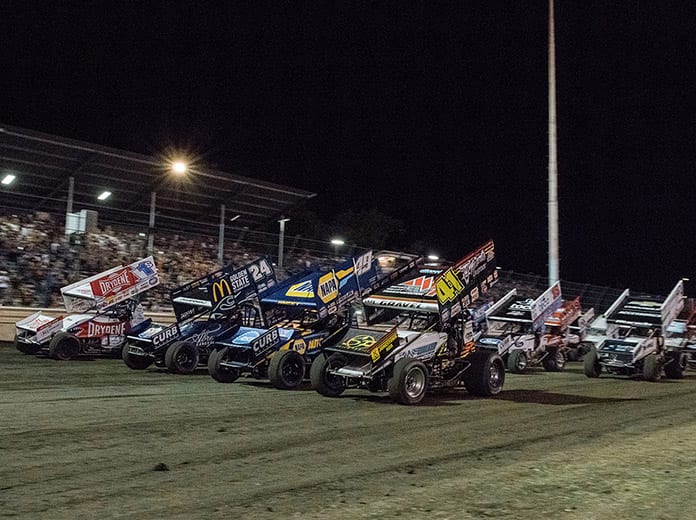
From the 1960s through the 1990s, Calistoga was the home track for the Northern Auto Racing Club, which raced there as many as a dozen times a year. Many of the track’s alumni are included in any who’s-who list of sprint car racing, including Jimmy Sills, Tim Green and Brent Kaeding.
Reigning World of Outlaws NOS Energy Drink Sprint Car Series champion Brad Sweet remembers hanging around the track as a kid. Tim Kaeding, Paul McMahan, Cory Eliason, Kyle Larson, Carson Macedo and Rico Abreu all cut some of their first laps in a sprint car at Calistoga.
There were only a handful of cars for the first race at Calistoga Speedway in October 1938. One of them was co-owned by the late Louie Vermeil, who had migrated to the town when he was 20 years old and spent the rest of his life shepherding racing at the track. Among the founders of ARA and NARC, Vermeil ruled over racing with the single-minded determination of a Steinbrenner or Lombardi, reflecting the passion he had for sprint cars.
“He was fair and he always played to the fans,” recalled Charlie Wolleson, a Napa Valley vintner who worked alongside Vermeil for half a century. “He used to remind racers that if it weren’t for the fans, they would have no place to race.”
Racing thrived on the reputation of Louie Vermeil. “My dad had the credibility in town to make decisions about the track,” said Dick Vermeil.
His stern demeanor led many to believe he was crusty and disgruntled. But those who truly knew Louie Vermeil realized he was more like French bread. Crusty on the outside and soft on the inside. Countless drivers went out the pit gate after a bad night with gas money that came out of Louie Vermeil’s pocket.
At Calistoga, racing was a family affair. One of Dick Vermeil’s first jobs was posting fliers on utility poles around town to promote the races. Age restrictions prevented him from pursuing his dream of being a racer, but he still drove the water truck to prep the track for racing.

“On race days, my mom (Alice) ran the ticket office and I still have a picture of my high school girlfriend who was the trophy presenter,” he added. That girlfriend, Carol, has been his wife for 64 years.
The Vermeil home was also a center of action on race weekends. The parking lot of Louie Vermeil’s garage would be littered with race cars under repair and hungry drivers and crews.
“My mom would host dinner for anybody who showed up, even if it was 100 people, and she would cook for two days,” Dick Vermeil said.
The relaxing mineral spas that drew tourists to Calistoga a century ago still draw them today. It is still a small town, with only 5,000 residents, but the population has changed.
“Generally, I believe most locals — especially the long-timers — still support the track,” contends Mayor Chris Canning, “but not so much the newcomers.”
“Calistoga is a retirement town and the newcomers don’t like the noise,” Vermeil noted. To adapt to the attitude of the newcomers and the needs of the tourist industry, Calistoga has been exclusively a special-events -only track for the last decade, hosting about eight nights of racing a year, including the season’s biggest event — the Louie Vermeil Classic — a Labor Day weekend tradition honoring the family that “built” Calistoga Speedway.
Reflecting Louie Vermeil’s passion for non-winged racing, the Classic featured USAC/CRA sprint cars and USAC Western States midgets over two days of racing. The fairgrounds were jammed with campers avoiding champagne-priced tourist hotels and enjoying beer and wine tasting during the afternoons. Last year, the King of the West 410 sprint cars replaced the midgets.
Two years ago, the nonprofit organization that had managed the 75-acre fairgrounds since its inception went bankrupt, the result of bad management and lack of supplemental funding from the state of California.
Prior to that, the city of Calistoga had been attempting to take control of the fairgrounds, which functions as the town’s civic center where quinceaneras, weddings and graduations are celebrated, civic organizations hold fundraisers, artists display their work, the local food bank collects donations and local golfers have a place to play.
Efforts to form a Joint Powers Agreement between the city and county to cooperatively manage the fairgrounds fell apart two years ago in the aftermath of wildfires that hit the Napa Valley. This spring, the city was on the verge of buying the fairgrounds from Napa County before the financial fallout from the COVID-19 pandemic nearly wiped out the city’s financial reserves.
Talks are continuing over the prospect of the city leasing the fairgrounds until it can rebuild its finances to complete a purchase.
“The fairgrounds are such an essential part of Calistoga and the speedway is part of our identity,” noted Canning. “It’s why we’ve worked so hard for the last four years to get it back from the county.”
Meanwhile, on Labor Day weekend, pending social-distancing guidelines, the tradition will continue and the “House That Louie Built” will come to life again.
